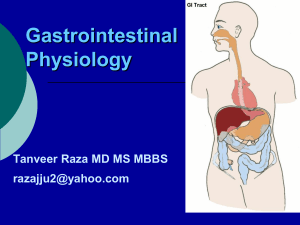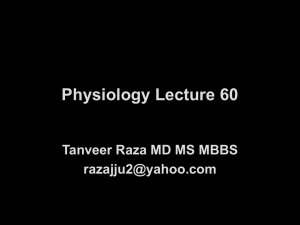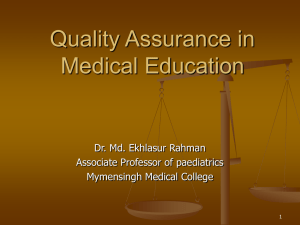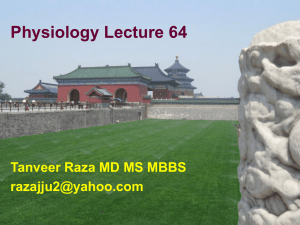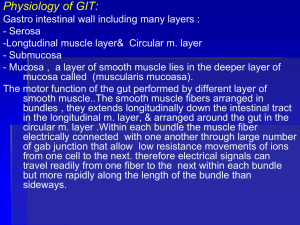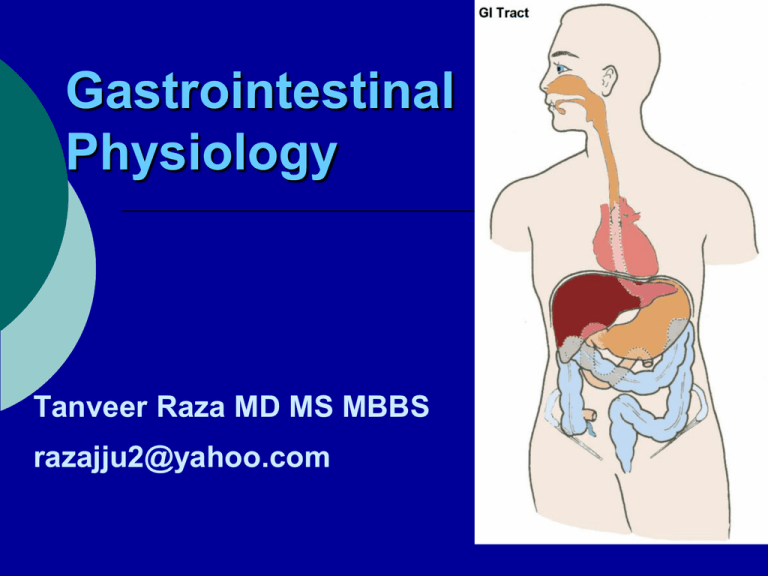
Gastrointestinal
Physiology
Tanveer Raza MD MS MBBS
razajju2@yahoo.com
Cross Section of Intestinal wall
Resting
membrane potential
Voltage can change to different levels
less negative
-56mv
Depolarization
At rest
more negative
Hyperpolarization
Tanveer Raza MD MS MBBS
razajju2@yahoo.com
GI Smooth Muscle:
Electrical Activity
Tanveer Raza MD MS MBBS
razajju2@yahoo.com
GI Smooth Muscle:
•
Slow waves
•
•
Electrical Activity
Not action potential
Spikes
•
True action potential
Tanveer Raza MD MS MBBS
razajju2@yahoo.com
GI Smooth Muscle:
Electrical activity
Slow waves
Not action potentials
Slow changes in resting membrane potentials
Rhythmic
Intensity and rhythm varies
Cause
Complex interaction between smooth muscle
cells and Interstitial cells of Cajal
Interstitial cells of Cajal
Electrical pacemaker for smooth muscle
cells
Tanveer Raza MD MS MBBS
razajju2@yahoo.com
GI Smooth Muscle:
Electrical activity
Slow wave
Spike potential
Not Action potential Action potential
Does not cause
calcium ions to
enter (only sodium
channels)
Calcium ions enter
Does not cause
muscle contraction
Causes muscle
contraction
Tanveer Raza MD MS MBBS
razajju2@yahoo.com
GI Smooth Muscle:
Electrical activity
Spike potential of GI
smooth muscle
Action potential of
large nerve fiber
Caused by CalciumSodium channels
Caused by Sodium
only
Slower to open and
close
Faster
Longer duration (1040 times)
Shorter
Tanveer Raza MD MS MBBS
razajju2@yahoo.com
GI Smooth Muscle:
Electrical activity
Calcium-Sodium Channels
Cause action potentials
Acts through Calmodulin
Large number of Ca++ enter along with
smaller number of Na+
Ca++ is required for contraction
Tanveer Raza MD MS MBBS
razajju2@yahoo.com
GI Smooth Muscle:
Tonic
Electrical activity
contraction
Some smooth muscles exhibit tonic
contraction
Continuous contraction
Lasting several minutes to hours
Cause
1. Continuous repetitive spike potentials
2. Hormones or other factors
3. Continuous entry of Ca++
Tanveer Raza MD MS MBBS
razajju2@yahoo.com
Movement in GIT
Propulsive
Moves food forward along GIT at an
appropriate rate for digestion and
absorption
Mixing
movements or Peristalsis
movements
Keeps intestinal contents thoroughly
mixed at all times
Tanveer Raza MD MS MBBS
razajju2@yahoo.com
Movement in GIT
Tanveer Raza MD MS MBBS
razajju2@yahoo.com
Movement in GIT: Peristalsis
A contractile ring appears around the
gut and then moves forward
Stimulation at any point in the gut can
cause a contractile ring to appear in
the circular muscle, and this ring then
spreads along the gut tube
Tanveer Raza MD MS MBBS
razajju2@yahoo.com
Movement in GIT: Peristalsis
Stimulus for intestinal peristalsis
Distention of the gut
Other stimuli
Irritation
Chemical or Physical
Parasympathetic nervous signals
Tanveer Raza MD MS MBBS
razajju2@yahoo.com
Movement in GIT: Peristalsis
Requires active myenteric plexus
Peristalsis is depressed or absent
Congenital absence of myenteric
plexus
Atropine (paralyzes cholinergic nerve
endings)
Directional movement toward Anus
Can occur in either direction but normally
occurs towards anus
Tanveer Raza MD MS MBBS
razajju2@yahoo.com
Movement in GIT: Peristalsis
Law of the Gut
Peristaltic reflex plus anal direction of
movement of peristalsis is called "law of
the gut”
Contractile
ring normally begins on orad side
of distended segment
The gut sometimes relaxes several
centimeters downstream toward the anus,
called "receptive relaxation," thus allowing
food to be propelled easily anally
Tanveer Raza MD MS MBBS
razajju2@yahoo.com
Movement in GIT: Peristalsis
Peristalsis also occurs in
Bile ducts
Glandular ducts
Ureters
Many other smooth muscle tubes of the
body
Tanveer Raza MD MS MBBS
razajju2@yahoo.com
Movement in GIT: Mixing Movement
Differ
in different parts
Peristaltic contractions causing
mixing
Occurs
when forward progression is
blocked by sphincter. Peristaltic wave
can then only churn the contents, rather
than propelling them
Local
intermittent constrictive
contractions
Tanveer Raza MD MS MBBS
razajju2@yahoo.com
Movement in GIT: Mixing Movement
Differ
in different parts
Peristaltic
contractions causing mixing
Local intermittent constrictive
contractions
Occurs every few centimeters in gut wall.
These constrictions usually last only 5-30
seconds; then new constrictions occur at other
points, "chopping" & "shearing" the contents
first here and then there
Tanveer Raza MD MS MBBS
razajju2@yahoo.com
Thank You

